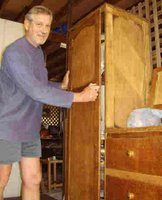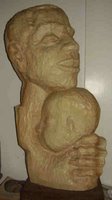 An old wood robe that was a bargain at a garage sale is today’s VIP guest in Classie Corner. Garage sales and classified advertising go together like Araldite part A and B, reaching maximum strength every Saturday morning in the pages of local papers everywhere. My creative spirit tried to make a similar bond between wood and technology. These inspired ramblings make their public debut here …
An old wood robe that was a bargain at a garage sale is today’s VIP guest in Classie Corner. Garage sales and classified advertising go together like Araldite part A and B, reaching maximum strength every Saturday morning in the pages of local papers everywhere. My creative spirit tried to make a similar bond between wood and technology. These inspired ramblings make their public debut here …
HIGH-tech irony may be a four-year-old computer on shelves in an 80-year-old piece of bedroom furniture, an old silky oak all-rounder with a wardrobe on one side and a dressing table on the other. Especially if the octogenerian hybrid has a slat of century-old cedar serving as an extension for the IBM keyboard.
The words spring from a half-century-old brain. The computer and the operator both carry the stigma that comes near obsolete. The wood is timeless. Technology changes. Thought processes change. Wood stays much the same inside even though the exterior shows the scars of time. Things are a little different with the computer, which seems virtually timeless on the outside while embracing change on the inside.
The old furniture may have served in the bedroom of a single gent or lady’s small flat. Its space-saving design indicates such a purpose. The first owners may have used the mirror to groom themselves before they went for a night out in 1920s Australia; men with oily hair plasted down and reeking of california poppy, women with curly waves and perhaps a small gold inlay on a smile like a silent-film star. All the layers of paint indicated that my hybrid unit had probably three owners with vastly different tastes.
The original finish was a brown stain. It must have been magnificent on the beautiful grain when the piece was new. Maybe it stood beside a silky bed in a room with little decorative touches like lace on the bedspread and window dressings and little cotton baubles on cute window shades. However, the wood finish may either have lost its lustre or found distaste with the culprit who applied a coat of bright yellow paint. Change brings reactions and more change. It seems to have a mindset to affect everything in its path but it stops just short of the heart.
The yellow was a nasty shock as we scraped off the warm off-white that the robe featured when we bought it for $5 at a garage sale. Inside the robe, the original brown carries a memento of a mother and daughter battle. "I hate mum" is scrawled in lipstick on an inside wall.
Flecks of the colours peep at me as I type. The yellow seems to give a flashback to a boldness of the 1950s or 60s. My sister, an interior decorator at the time, practised her designing on my bedroom with a colour scheme that always seemed to me to underscore a scorning of the subdued and restful shades of the homes of the post-war era. Her scheme for me centred on a red feature wall. The other walls were grey; the ceiling was olive green. Every other such surface in the house was duck-egg blue or another pastel.
We became the sort of family that would grasp the nettle and cover the perceived dullness of the old-fashioned timber with shades so bright we may have needed sunglasses when combing our hair. In my mind I can see my mum with a paintbrush in her hand and curlers in her hair. She gave up smoking when I was a young child but in this vision she still has a cigarette. A bakelite radio plays from the shelf above the scared marble benchtop between the sink and the stove. A Jobim tune with lush strings fills the country kitchen, the walls of which are a warm and bright yellow, above a black and white checked vinyl. At least I think it was a Jobim tune. One called Surfboard to be exact. I have it on an LP record dated 1965 so it’s about the right era. The first time I heard it as an adult it took me back to the 60s.
My sister also us to a product I think was called Fablon, which left us with fake plastic woodgrain over paint that covered up real grain. We all dressed up to go to church each Sunday, even though I could not bring myself to believe that a small slice of bread became the body of Christ but tentatively accepted that Jesus Christ was God’s Son who was Born after a so-called Immaculate Conception.
A pale yellow refrigerator with a small pressed-metal brandplate saying "Silent Knight" was next to a worn pine table opposite the brick fireplace in our old kitchen. The old fridge, which just a few years before my birth replaced a made way for a shiny new white unit with a "Kelvinator" plate in plastic; the radio became a square wooden box framing an aluminium speaker housing and modern plastic nobs in two shades of grey; the fireplace almost went cold as we eased our reliance on the wood supply and complained about the fumes from a kerosene heater.
That’s just a bit of one era of all this robe-dresser has seen. Pale memories of wood valued for itself, then treated with coats of paint to suit ephemeral needs for aesthetic satisfaction, then again valued for itself but with plastic and silicon filling its guts.
The same sorts of changes must have been going on in other people’s lives.
The tall part of the unit, with the dowel rail still across the top, stands before me like a grotesque upright coffin as I sit typing on the keyboard, the roll-out chipboard shelf rattling and setting up sympathetic vibrations through another chipboard shelf that supports the monitor.
Yes, the cupboard appears to have a place in a new order. It looks the same as it did before technology tried to take over every little space within it. Disks in one drawer; cables and disused bits of hardware in another; user manuals and technology in another; a disgusting collection of broken pens and all sorts of bits and pieces in the fourth.
Under the keyboard shelf, right in front of my feet, two cardboard boxes contain relics from my life’s work in paper publishing.
Above them, the monitor shows my explorations into a new universe about as far from the world of wood and paper as the furthest piece of matter orbiting the furthest star, maybe even further. It’s also a long way from the country kitchen with the bakelite radio.
The old robe now has a brain inside a plastic and steel box that sits above the monitor and connects with my brain and the world.
The design provided a top shelf to hold a printer but my latest "three-in-one" unit won’t fit. Just like any computer product, the "next generation" came quickly and was surprisingly difficult to integrate into the set-up with the robe.
The new print-scan-copy device provides its own contrast on an old 1800s cedar desktop that a family member gave to us.
Wonderful wood is propping up technology at least around our place.
FOOTNOTE: The robe served its sentence in hard labour and has gone into semi-retirement in storage awaiting yet another application.
I have also updated my hardware, software and internet connection but the performance has not improved as much as I hoped.
My new secondhand desk has a woodgrain laminex top.
STILL to come in the Classie Corner wood series: The way Australian pioneers felled the cedar forests, a new look at the camphor laurel pest and lots more.








